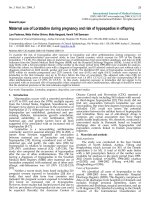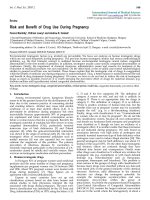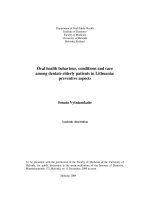OMNIPAQUE oral use vietnam
Bạn đang xem bản rút gọn của tài liệu. Xem và tải ngay bản đầy đủ của tài liệu tại đây (1.47 MB, 52 trang )
Iodinated Contrast Media for Oral Use
Low-osmolar Non-ionic Iohexol
1
GE Title or job number
7/18/2012
Many
Examples of
Use of
Contrast
Media in
Imaging
Cardioangiography
CT enhancement
Urography
Cerebral
angiography
VenographyJ
Peripheral
angiography
Radiographic Imaging of the
GI Tract: Use of Oral Contrast media (CM)
X-ray Examinations
Conventional
(Plain Film)
Fluoroscopy
- CM
IV
Fluoroscopy
+ CM
Oral
CT
+ CM
CT
- CM
IV
Types of Oral Positive CM
LOCM
HOCM
BARIUM
HOCM, High-Osmolar Contrast Media
LOCM, Low-Osmolar Contrast Media
Types of Commercially Available Oral Positive C
Barium sulfate suspensions
Many preparations available
Water soluble
High-Osmolar Contrast Media: diatrizoate preparations
Low-Osmolar Contrast Media: iohexol
Freeman A. Textbook of Contrast Media. 1999:135-148.
Ott DJ et al. JAMA. 1983;249:2380-2384.
Differing Osmolalities
Osmolality ranges of different contrast media at 37°C in relation to blood (mOsm/kgH 2O) at
most commonly used concentrations
2130+
1870
Iodixanol, at all iodine concentrations is the only contrast
medium available for intravascular use with osmolality equal
to blood
915
521
290
290
Blood
Visipaque
LOCM
HOCM
Advantages and Disadvantages of Current
Oral CM
Properties of an Ideal Oral CM
Safe - Low risk if aspirated or leaked into the peritoneum
Tolerable - Low GI side effects
Palatable - Acceptable taste
Low viscosity - Easy to swallow
Effective - Provides adequate contrast delineation
Water soluble - Uniform distribution
Fluid enough to pass through narrow areas
Seltzer SE et al. CRC Crit Rev Diagn Imaging.
1979;12:77-99.
Barium Sulphate
Advantages:
Historically a preferred agent for
opacification of the GI tract
Dense
Not absorbed from the GI tract
Usually safe
Readily available
May be less expensive
Cohen MD. Radiology. 1987;162:447-456.
Freeman A. Textbook of Contrast Media. 1999:135-148.
Barium Sulphate
Disadvantages:
Physical instability
Contraindicated if there is a suspected
perforation
Can be fatal if aspirated
Bitter taste, chalky
Difficult to swallow large volumes
Freeman A. Textbook of Contrast Media. 1999:135-148.
Oral HOCM (Ionic-Monomers)
Advantages:
Water soluble (ie, solutions, not suspensions)
Readily absorbed by peritoneum if leaked from the GI tract
Pass through small bowel rapidly
Can be diluted to desired concentration
HOCM, High-Osmolar CM
Cohen MD. Radiology. 1987;162:447-456.
Freeman A. Textbook of Contrast Media. 1999:135-148.
Oral HOCM (Ionic-Monomers)
Disadvantages:
Poor visualization of distal GI
tract
Possible toxicity to bowel mucosa
Possible fluid shifts and
dehydration- due to high
osmolarity
Adverse events if aspirated
Some patients may have
sensitivity to iodinated contrast
Can cause mild-to-severe GI
distress (eg, diarrhea, nausea,
vomiting, cramps)
HOCM, High-Osmolar CM
Cohen MD. Radiology. 1987;162:447-456.
Freeman A. Textbook of Contrast Media. 1999:135-148.
Oral LOCM (Non-Ionic Monomers)
Advantages:
Well-accepted by patients due to
neutral taste *
Rapidly absorbed from the peritoneum
Rapidly dissipated from the lungs if
aspirated
Can be used where barium is
contraindicated or not tolerated
CT colonography
tagging 88 y/o female
LOCM, Low-Osmolar CM
Cohen MD. Radiology. 1987;162:447-456; Omnipaque package insert.
Smevik B, et al. Contrast Media in Pediatric Radiology. 1987:79-80. *
Oral LOCM (Non-Ionic Monomers)
Disadvantages:
Lower attenuation of X-rays
than barium (Fluoroscopy)
Possible GI discomfort
(eg,diarrhea, nausea,
vomiting)
Some patients may have
sensitivity to iodinated
contrast
LOCM, Low-Osmolar CM
Cohen MD. Radiology. 1987;162:447-456; Omnipaque package insert.
Smevik B, et al. Contrast Media in Pediatric Radiology. 1987:79-80. *
Indications and Guidelines for Iodinated Contra
Media Use in CT
Water-soluble contrast agents are preferred over barium agents
the following situations:
Suspected GI perforation
Risk of aspiration
Administration before bowel surgery
Administration before endoscopy
As a bowel marker for percutaneous CT-guided interventional
procedures
Iohexol (Omnipaque) is the only LOCM approved by the FDA for oral us
LOCM, Low-Osmolar CM
American College of Radiology. Manual of Contrast Media. Version 5.0;
/>Omnipaque package insert; Ultravist package insert; Isovue package insert; Optiray package insert.
Administration of Oral Contrast Media
Diluting Omnipaque
Dilute oral plus i.v. Omnipaque:
• Useful when unenhanced imaging does not provide sufficient delineatio
between normal loops of the bowel and adjacent organs or areas of
suspected pathology
• Diluted to concentrations from 6-9 mgI/mL administered orally in
conjunction with i.v. Omnipaque 300 is indicated in adults for use in CT
the abdomen.
Omnipaque 350
(350 mg I/mL)
25 mL to final 1 liter
Omnipaque 350 mgI/mL is indicated in adults for use in oral pass thru
examination of the GI tract.
ORAL USE
The importance of taste
• Bowel opacification is predominantly a function of volume of contrast
consumed and time elapsed to scanning
• If a contrast medium for oral use is not unpleasant to taste, patients
are more likely to be able to drink the volume required - not to
mention feel satisfied with the radiology experience
ORAL USE
• Hypertonic agents draw fluid from the plasma and interstitium into the bowel,
resulting in progressive loss of radiocontrast through dilution as the agent
travels through the gut
- Omnipaque provided better contrast density than sodium diatrizoate in
adults with suspected intestinal obstruction
- Omnipaque is well suited for visualisation of intestinal loops and provided
good quality scans in children of all ages
- Omnipaque was well tolerated in a range of patients of various ages posing
major management problems
Clinical comparison :
Omnipaque ( iohexol ) with other iodinate
contrast media
Lönnemark et al Study:
Oral contrast media in CT of the abdomen. Iohexol of different concentratio
a gastrointestinal contrast medium.
Aim: a double blind randomised study to compare 3 different concentrations of
Omnipaque when given orally (by mouth) to adults for bowel opacification in abdominal
CT.
Method: Omnipaque 350 was diluted in water 78-fold, 52-fold and 39-fold respectively to
obtain final concentrations of 4.5, 6.75 and 9 mgI/ml . A total of 30 patients were given
800mL of diluted contrast to drink; each concentration was given to 10 patients. Patients
were asked to grade the taste of Omnipaque on a scale between 0 ("awful") and 100
("good taste" or no problem to drink").
Results: No significant differences between the 3 Omnipaque concentrations were found
regarding enhancement, distribution or patient tolerability. The mean tolerability scores
ranged from 60-75. Texture had mean score ranging from 75-86 on the same scale.
When using Omnipaque as a bowel CM for CT the concentration of 4.5 mgI/ml was
sufficient for bowel opacification. In addition, these patients would repeat the
procedure with oral Omnipaque if required.
Acta Radiol 1995; 36(4):396-398.
Jobling et al Study
The use of non-ionic water-soluble contrast agents for small bowel followthrough examination.
Aim: This study retrospectively reviewed a consecutive series of small bowel
examinations using non-ionic CM to determine their efficacy.
Method: A total of 52 water-soluble non-ionic small bowel follow-through examinatio
were performed in 42 adult patients, using 100 ml Omnipaque 350 mgI/ml. Images
retrospectively assessed for radiographic quality and clinical findings, and compared with
operative findings and clinical outcomes.
Results: Obstruction was diagnosed in 12 patients, of whom 7 proceeded to surgery
(which confirmed the radiological diagnosis). Fistulae were found in 11 patients, of which 8
went to surgery (which confirmed the radiological diagnosis). 5 patients whose X-ray
excluded obstruction or fistulae went to surgery and in none of these patients w
either obstruction or fistula found - thus demonstrating the accuracy of the radiological
procedure.
The authors emphasise that non-ionic CM are particularly valuable in clinically complex patie
with major management problems, e.g. where there is doubt about the site, possible perforat
impending surgery.
Eur Radiol 1999; 9(4):706-710
Diederichs et al Study:
Oral administration of intravenous contrast media: a tasty alternative t
conventional oral contrast media in computed tomography
Aim:
Since many oral CM have a strong metallic taste, this study attempted
to identify CM with a better or neutral taste, whilst still achieving
optimal image quality.
Results:
There were no significant differences in radiographic enhancemen
between the CM.
Rofo 2007; 179(10):1061-1067.
Diederichs et al Study:
Oral administration of intravenous contrast media: a tasty alternative to
conventional oral contrast media in computed tomography
• With a score of 8, Omnipaque diluted with water came top in a taste test of various
contrast media
Smevik et al Study
Iohexol for contrast enhancement of bowel in pediatric abdominal C
Aim: This study in children examined the tolerability of oral diluted Omnipaque and the quality
of the images obtained.
Method: Abdominal CT scans from 160 paediatric bowel examinations with Omnipaque, at a
concentration of 6-7 mgI/ml were evaluated retrospectively. Over 80% of the patients had an
oncological (cancer) diagnosis.
Omnipaque was diluted with a drink of the patient's choice. The dilution was 1m
Omnipaque in 50ml of water, juice, lemonade or milk. In this mixture, the taste of
Omnipaque itself was undetectable.
39 out of 142 children drank the full volume of dilute Omnipaque. The remaining pat
eceived Omnipaque rectally.
Oral Omnipaque is well-tolerated in paediatric age-group
Acta Radiol 1990; 31(6):601-604









